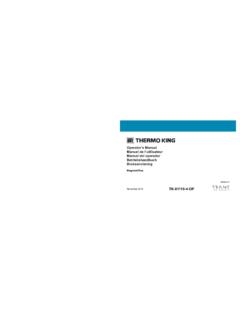Transcription of Greenhouse Gas Inventory Guidance: Fugitive Emissions
1 Greenhouse Gas Inventory GuidanceDirect Fugitive Emissions from Refrigeration, Air Conditioning, Fire Suppression, and Industrial GasesNovember, 2014 The EPA Center for Corporate Climate Leadership s (The Center) GHG guidance is based on The Greenhouse Gas Protocol: A Corporate Accounting and Reporting Standard (GHG Protocol) developed by the World Resources Institute (WRI) and the World Business Council for Sustainable Development (WBCSD). The Center s GHG guidance is meant to extend upon the GHG Protocol to align more closely with EPA-specific GHG calculation methodologies and emission factors, and to support the Center s GHG management tools and its Climate Leadership Awards initiative. For more information regarding the Center for Corporate Climate Leadership, visit EPA Center for Corporate Climate Leadership GHG Inventory GuidanceIITable of Contents Section 1: Introduction .. Greenhouse Gases Included .. Manufacturing vs. Use Phase Emissions .
2 2 Section 2: Methods for Calculating Emissions .. Screening Method .. Refrigeration and Air Conditioning Equipment Screening .. Fire Suppression Equipment Screening .. Method for Purchased Material Balance Method .. Simplified Material Balance Method ..10 Section 3: Choice of Activity and Emission Factors .. Screening Method .. Method for Purchased Material Balance Method .. Simplified Material Balance Method ..13 Section 4: Completeness ..14 Section 5: Uncertainty Assessment ..15 Section 6: Documentation ..16 Section 7: Inventory Quality Assurance and Quality Control (QA/QC) ..17 Table of EPA Center for Corporate Climate Leadership GHG Inventory GuidanceIIIS ection 1: EPA Center for Corporate Climate Leadership GHG Inventory Guidance1 Fugitive Emissions GuidanceSection 1: IntroductionAn important category of Scope 1 direct Greenhouse gas (GHG) are Fugitive Emissions , which result from the direct release to the atmosphere of GHG compounds from various types of equipment and processes.
3 This guidance document focuses on several Fugitive Emissions sources that are common for organizations in many sectors: refrigeration and air conditioning systems, fire suppression systems, and the purchase and release of industrial gases. Historically, air conditioning and refrigeration equipment utilized various Ozone Depleting Substances (ODSs), primarily chlorofluorocarbons (CFCs) and hydrochlorofluorocarbons (HCFCs). However, in accordance with the Clean Air Act Amendments of 1990 (Title VI) and the Montreal Protocol, these ODSs are being phased out of manufacture and use in the United (HFCs) and, to a lesser extent, perfluorocarbons (PFCs) are used as substitutes for the regulated ODSs. In addition, some air conditioning and refrigeration systems use non-halogenated refrigerants such as ammonia, carbon dioxide (CO2), propane, or isobutane. Also, some fire suppression equipment, which historically used ozone-depleting halons, use carbon dioxide (CO2), inert gases, and other from the refrigeration and air conditioning sector result from the manufacturing process, from leakage and service over the operational life of the equipment, and from disposal at the end of the useful life of the equipment.
4 These gases have 100-year global warming potentials (GWPs), which are typically greater than 1,000 times that of CO2, so their potential impact on climate change can be significant (see examples in Table 1). By the same token, any reductions of these gases can have a large potential guidance document addresses the following: Emissions from users of refrigeration and air conditioning equipment including household refrigeration, domestic air conditioning and heat pumps, mobile air conditioning, chillers, retail food refrigeration, cold storage warehouses, refrigerated transport, industrial process refrigeration, and commercial unitary air conditioning systems. Emissions from fixed and portable fire suppression equipment. Direct Emissions from purchased industrial gases. These gases can be used in processes such as manufacturing, testing, or laboratory applications. Emissions from aerosols, solvent cleaning, foam blowing, or other applications are not addressed by this 1: EPA Center for Corporate Climate Leadership GHG Inventory Guidance2 Fugitive Emissions Greenhouse Gases IncludedThe Emissions sources addressed by this guidance document could result in Emissions of any of the GHGs included in Table 1.
5 Ozone depleting substances include a number of different compounds such as CFCs, HCFCs, and halons, all of which have global warming potentials. As mentioned, these ODSs are being phased out of production due to their ozone depleting properties. However, some entities may still use these substances directly or in blends within refrigeration, air conditioning, or fire suppression is customary to exclude CFCs, HCFCs, and halons from GHG inventories because they are regulated and are being phased out by the Clean Air Act. These substances are also excluded from GHG inventories because their global warming potentials are complicated by the fact that they deplete stratospheric ozone, which is a Greenhouse gas. The GHG Protocol allows for reporting of these ODSs as separate memo items on an organization s GHG Inventory . They are reported as total release of gases but no global warming potentials are applied and they do not contribute to an organization s total CO2-equivalent Emissions Inventory .
6 Therefore, organizations that currently use ODSs and switch to HFCs or PFCs may show an increase in their overall GHG Emissions Inventory . Documenting the use of these ODSs will help communicate the reasons for this increase. Manufacturing vs. Use Phase EmissionsThis document only applies to Scope 1 GHG Emissions resulting from operations at the reporting organization s facilities. For refrigeration, air conditioning, and fire suppression equipment, these Emissions may take place during the installation, use, or disposal. Refrigerants and fire suppressants may be released from equipment leaks throughout their operating life or from catastrophic leaks. Also, when equipment is installed, repaired, or removed, refrigerants and fire suppressants may be released if proper recovery processes are not used. Fire suppressants are also emitted to extinguish fires. Emissions that occur during the manufacturing or disposal of equipment or purchased gases are Scope 3 indirect Emissions , and are not included in an organization s Scope 1 Emissions .
7 Section 1: EPA Center for Corporate Climate Leadership GHG Inventory Guidance3 Fugitive Emissions GuidanceTable 1: Global Warming PotentialsCommon NameFormulaGWP*Carbon dioxideCO21 MethaneCH425 Nitrous oxideN2O298 Sulfur hexafluorideSF622,800 Nitrogen trifluorideNF317,200 HFC-23 CHF314,800 HFC-32CH2F2675 HFC-41CH3F92 HFC-125C2HF53,500 HFC-134 CHF2 CHF21,100 HFC-134aC2H2F41,430 HFC-143CH2 FCHF2353 HFC-143aC2H3F34,470 HFC-152CH2 FCH2F53 HFC-152aC2H4F2124 HFC-161CH3CH2F12 HFC-227eaC3HF73,220 HFC-236cbCH2 FCF2CF31,340 HFC-236eaCHF2 CHFCF31,370 HFC-236faC3H2F69,810 HFC-245caCH2 FCF2 CHF2693 HFC-245faCHF2CH2CF31,030 HFC-365mfcCH3CF2CH2CF3 794 HFC-43-10meeCF3 CHFCHFCF2CF3 1,640 PFC-14CF47,390 PFC-116C2F612,200 PFC-218C3F88,830 PFC-318c-C4F810,300 PFC-3-1-10C4F108,860 PFC-4-1-12C5F129,160 PFC-5-1-14C6F149,300 PFC-9-1-18C10F18>7,500*100-year GWPs from Intergovernmental Panel on Climate Change (IPCC) Fourth Assessment Report (2007)Section 1: EPA Center for Corporate Climate Leadership GHG Inventory Guidance4 Fugitive Emissions GuidanceTable 2.
8 GWPs for Refrigerant BlendsASHRAE #Blend CompositionGWP*R-401A53% HCFC-22 , 34% HCFC-124 , 13% HFC-152a16R-401B61% HCFC-22 , 28% HCFC-124 , 11% HFC-152a14R-401C33% HCFC-22 , 52% HCFC-124 , 15% HFC-152a19R-402A38% HCFC-22 , 6% HFC-125 , 2% propane2,100R-402B6% HCFC-22 , 38% HFC-125 , 2% propane1,330R-403B56% HCFC-22 , 39% PFC-218 , 5% propane3,444R-404A44% HFC-125 , 4% HFC-134a , 52% HFC 143a3,922R-406A55% HCFC-22 , 41% HCFC-142b , 4% isobutane0R-407A20% HFC-32 , 40% HFC-125 , 40% HFC-134a2,107R-407B10% HFC-32 , 70% HFC-125 , 20% HFC-134a2,804R-407C23% HFC-32 , 25% HFC-125 , 52% HFC-134a1,774R-407D15% HFC-32 , 15% HFC-125 , 70% HFC-134a1,627R-407E25% HFC-32 , 15% HFC-125 , 60% HFC-134a1,552R-408A47% HCFC-22 , 7% HFC-125 , 46% HFC 143a2,301R-409A60% HCFC-22 , 25% HCFC-124 , 15% HCFC-142b0R-410A50% HFC-32 , 50% HFC-1252,088R-410B45% HFC-32 , 55% HFC-1252, HCFC-22 , 11 HFC-152a , propylene14R-411B94% HCFC-22 , 3% HFC-152a , 3% propylene4R-413A88% HFC-134a , 9% PFC-218 , 3% isobutane2,053R-414A51% HCFC-22 , HCFC-124 , HCFC-142b0R-414B5% HCFC-22 , 39% HCFC-124 , HFC-125 , 5% HFC-134a , butane2, HFC-125 , HFC-134a , isobutane3, HFC-125 , HFC-134a , isobutane2, HFC-227ea , HFC-134a 2, HFC-125, 47% HFC-134a, butane/pentane2, HFC-125, 93% HFC-134a, butane/pentane1, HFC-125 , 2% HFC-143a , isobutane3, HFC-125, 16% HFC-134a, 18% HFC-143a, isobutane3, CFC-12 , HFC-152a , HCFC-22 , HFC-32 , CFC-115325R-5075% HFC-125 , 5% HFC143a3,985R-508A39% HFC-23 , 61% PFC-11613,214R-508B46% HFC-23 , 54% PFC-11613,396* 100-year GWPs from Intergovernmental Panel on Climate Change (IPCC) Fourth Assessment Report (2007).
9 GWPs of blended refrigerants are based on their HFC and PFC constituents, which are based on data from EPA Center for Corporate Climate Leadership GHG Inventory Guidance5 Section 2: Methods for Calculating EmissionsFugitive Emissions GuidanceSection 2: Methods for Calculating EmissionsMost large organizations will have Emissions from refrigeration and air conditioning equipment in one form or another. However, the potential Emissions sources and level of data available may differ greatly. For instance, a supermarket chain with large refrigeration systems may have on-site storage of refrigerants and track detailed data concerning refrigerant use, while an industrial organization may simply use air conditioning in its office space and not track detailed data on refrigerant use. Often organizations whose core business does not include the use of this type of equipment exclude the associated GHG Emissions from their GHG Inventory as not material. However, the materiality of a source can only be established after it has been assessed.
10 This does not necessarily require a rigorous quantification of all sources, but at a minimum, an estimate based on available data should be developed for all sources of methods with varying levels of accuracy and data collection required are outlined in this guidance to calculate GHG Emissions . Organizations may calculate Fugitive GHG Emissions from refrigeration and air conditioning equipment, fire suppression systems, or purchased industrial gases with one of the following methods. Section describes a preliminary Screening Method to estimate Emissions from refrigeration, air conditioning, and fire suppression equipment based on the type of equipment used and emission factors. This method requires the least actual data collection and is not applicable for quantifying Emissions from purchased gases. It is recommended that this method be used only as a screening tool because the Emissions factors used in the approach are highly uncertain. Emission factors vary between individual pieces of equipment and also vary over time.











